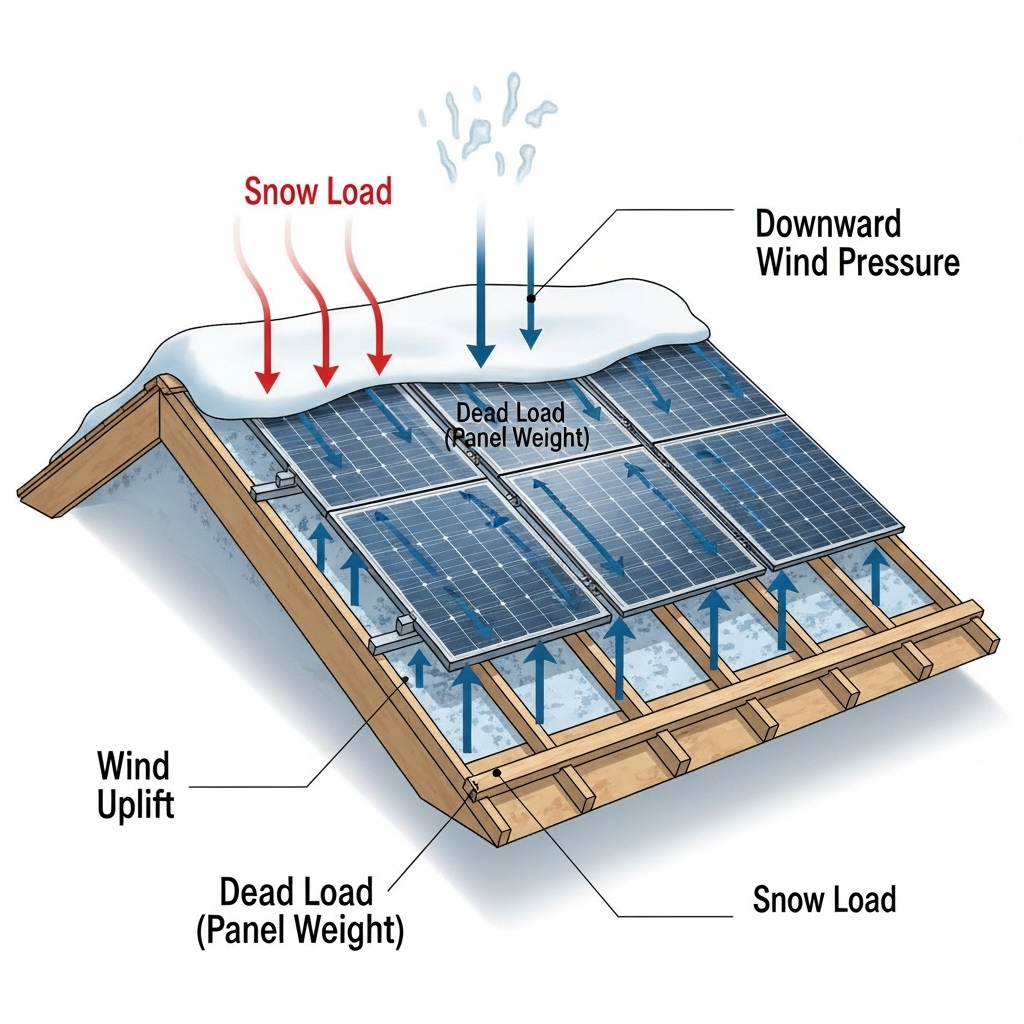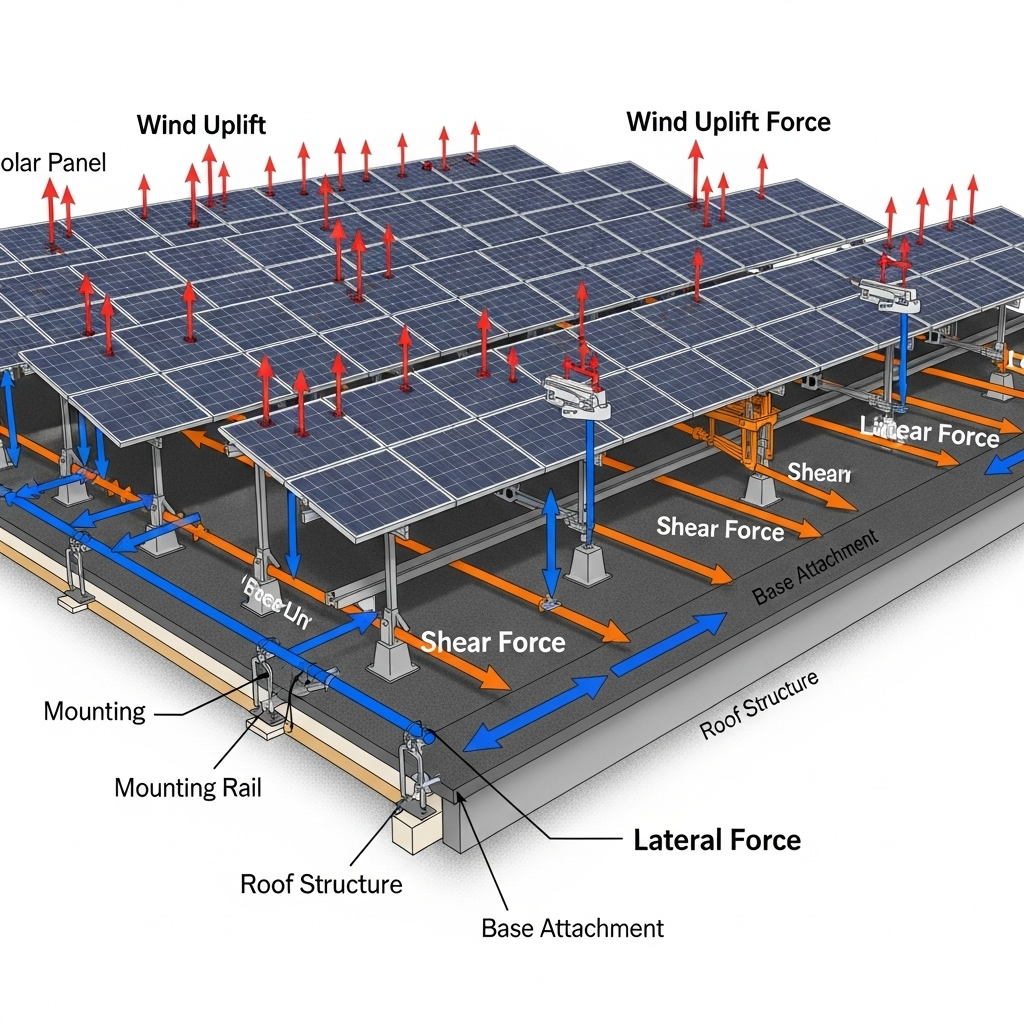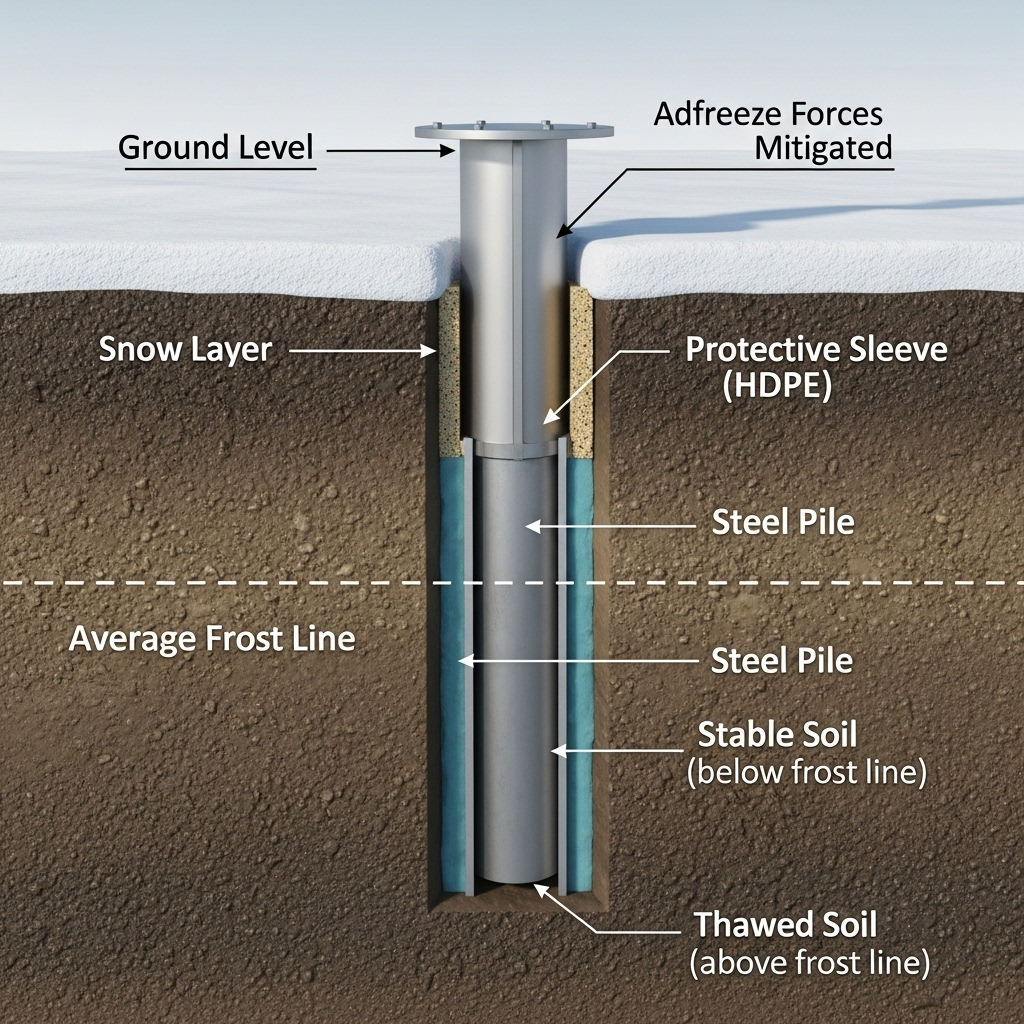The global adoption of solar energy is accelerating at an unprecedented rate. According to a report from the IEA, the world installed 446 GW of new solar PV systems in 2023 alone, bringing the total capacity to 1.6 TW. As more homeowners and businesses turn to rooftop solar, a critical and often overlooked element is the structural integrity of the roof itself. The mounting system, or racking, is the foundation of your solar array, and understanding the forces it must withstand is paramount for a safe, durable, and effective installation.
This overview provides a data-backed look at solar panel racking loads, drawing on engineering principles and the broader context of quality and safety emphasized by international bodies like the International Energy Agency (IEA) and the International Renewable Energy Agency (IRENA). Ensuring your roof can handle the demands of a solar installation is the first step toward long-term energy independence.
Understanding the Forces on Your Roof
A solar racking system must manage a variety of forces to keep the panels secure and your roof intact. These forces, or loads, are not static; they change with weather, location, and time. A professional assessment considers all these factors, but understanding the basics helps you appreciate the engineering behind a secure installation.
Static vs. Dynamic Loads
The loads acting on your roof are categorized into two main types: static and dynamic. Static loads are constant and predictable, primarily the 'dead load' of the solar installation itself—the combined weight of the panels, racking, and any additional hardware. Dynamic loads are variable and often unpredictable, created by environmental factors like wind, snow, and seismic activity. Properly engineered roof mounting systems are designed to handle both.
Key Load Types Explained
- Dead Load: This is the most straightforward calculation. A typical residential solar panel weighs around 40 pounds (about 18 kg). When combined with racking, the total added weight is usually about 3 to 4 pounds per square foot (PSF). Most modern roofs, built to code, can easily support this distributed weight.
- Wind Load: This is arguably the most critical dynamic force. Wind doesn't just push down on panels; it can also create significant upward pressure, known as uplift. In areas prone to high winds, uplift forces can be powerful enough to detach panels from the roof if not properly secured. Engineering standards, such as ASCE 7, provide detailed methods for calculating wind loads based on geographic location, building height, and roof shape.
- Snow Load: In colder climates, accumulated snow can add a substantial, temporary load to a roof. The weight of snow varies; light, fluffy snow weighs much less than wet, heavy snow. Racking systems must be strong enough to support the maximum expected snow load for a specific region, which can range from 30 PSF in the Midwest to over 60 PSF in mountainous areas.
How Racking Systems Distribute Solar Panel Loads
The primary function of a roof mounting system is to safely transfer all the loads from the solar panels to the building's structural frame. The design and components of the racking system are critical to achieving this without concentrating stress on vulnerable points of the roof.

The Role of Mounting Components
A typical racking system consists of rails that span the roof, clamps that secure the panels to the rails, and footings that anchor the entire system to the roof's rafters or trusses. Each component is vital for load distribution. The quality of these components is directly tied to the safety and longevity of the system. An IEA report on solar supply chains highlights that racking and mounting manufacturing provides a significant number of jobs, underscoring its importance as a specialized segment of the solar industry. *According to the Solar PV Global Supply Chains report, racking and mounting make up nearly 20% of PV manufacturing jobs in the United States.* This specialization ensures components are built to withstand specific structural stresses.
Point Loads vs. Distributed Loads
Installers aim to minimize roof penetrations to reduce the risk of leaks. However, this means the entire weight of the array is transferred to the roof structure through a few anchor points. This creates 'point loads.' A structural engineer must verify that the roof's rafters are strong enough to handle these concentrated forces. The racking system's rails help distribute these point loads across multiple structural members, preventing any single point from being overloaded.
IEA & IRENA Perspectives on System Safety and Quality
While organizations like the IEA and IRENA focus on global energy trends, their data underscores the massive scale of solar deployment and the corresponding need for high standards in every component, including racking. The rapid growth of solar PV makes quality control and adherence to engineering best practices more important than ever.
The Global Rise of Distributed PV
The incredible growth in rooftop solar installations worldwide necessitates robust, standardized safety protocols. *A special report by the IEA, Solar PV Global Supply Chains, notes that putting the world on a path to net-zero emissions requires solar PV to expand on an even greater scale.* This expansion relies on consumer confidence, which is built on safe and reliable installations. A failed racking system not only damages a roof but also harms the industry's reputation.
Manufacturing Quality and Long-Term Reliability
The reliability of a solar installation is only as strong as its weakest link. High-quality racking made from durable materials like aluminum or galvanized steel is essential for managing loads over the 25-30 year lifespan of the solar panels. The IEA's analysis of the solar supply chain emphasizes the importance of every manufactured component in achieving global clean energy goals.
Integrating with Energy Storage
A secure racking system is the physical foundation for a high-performance energy system, which increasingly includes battery storage. The structural integrity of the solar array ensures consistent energy production, which is vital for optimizing battery performance and achieving energy independence. For a deeper analysis of how solar and storage work together, you can review the ultimate reference on solar storage performance, which details how a stable energy source maximizes the value of your entire system.
A Data-Driven Look at Racking Loads
To make these concepts more concrete, it's helpful to look at some typical numbers. These figures are illustrative; a professional installer will perform precise calculations for your specific property based on local building codes and conditions.
Typical Weight and Load Specifications
The following table provides average values for different loads. Note how dynamic loads from wind and snow can far exceed the static weight of the equipment itself.
| Load Type | Typical Value (per square foot) | Notes |
|---|---|---|
| Solar Panels & Racking (Dead Load) | 3-4 lbs | This is the constant weight added to the roof. |
| Snow Load (Live Load) | 20-60+ lbs | Highly dependent on climate. A foot of wet snow can weigh over 20 lbs. |
| Wind Uplift Load | 20-50+ lbs | Varies based on wind speed, roof height, and location on the roof (edges and corners experience higher forces). |
Regional Variations are Critical
Load requirements are not one-size-fits-all. A roof in a hurricane-prone area like Florida requires a mounting system with a high wind uplift rating, while a roof in the Rocky Mountains must be designed to handle heavy snow accumulation. Local building codes codify these regional requirements, and adherence is mandatory for a safe and permitted installation.
Building a Secure Energy Future
Understanding roof racking loads is not just an academic exercise; it's fundamental to the safety, durability, and performance of your solar energy system. While global organizations like the IEA and IRENA track the big picture of solar deployment, the success of this energy transformation rests on the quality of individual installations. By ensuring your roof mounting system is properly engineered and installed to handle all static and dynamic loads, you are building a secure foundation for decades of clean, reliable power.
Disclaimer: This article is for informational purposes only and does not constitute professional engineering or legal advice. Always consult with a qualified structural engineer and a professional solar installer to assess your specific situation.
Frequently Asked Questions
How much weight do solar panels add to a roof?
Solar panels and their mounting hardware typically add about 3 to 4 pounds per square foot (PSF) to a roof. For a standard residential system, this distributed load is well within the capacity of most modern roofs built to code.
Can my roof handle the weight of solar panels?
Most modern homes can support the weight of solar panels without issue. However, it is essential to have a structural assessment performed by a qualified professional before installation. They will check the condition of your roof structure, consider the point loads from the mounting feet, and ensure compliance with local building codes.
What is wind uplift and why is it important for solar racking?
Wind uplift is the suction force created when wind blows over the surface of the solar panels and roof. This force can be stronger than the downward weight of the system and can pull panels off the roof if the racking is not securely anchored. Proper engineering and installation are critical to resist these uplift forces, especially in areas with high winds.
Do I need to remove snow from my solar panels?
Generally, no. Solar panels are designed to withstand significant snow loads, and the dark surface of the panels often encourages snow to melt and slide off naturally. In areas with exceptionally heavy snowfall, your system will be engineered with a tilt angle and structural strength to manage the expected accumulation.





Leave a comment
All comments are moderated before being published.
This site is protected by hCaptcha and the hCaptcha Privacy Policy and Terms of Service apply.